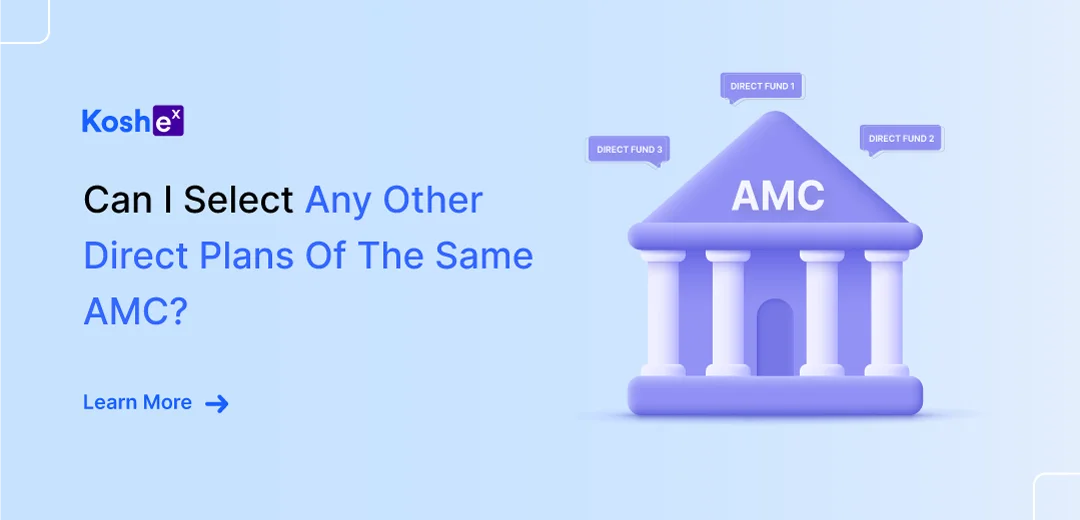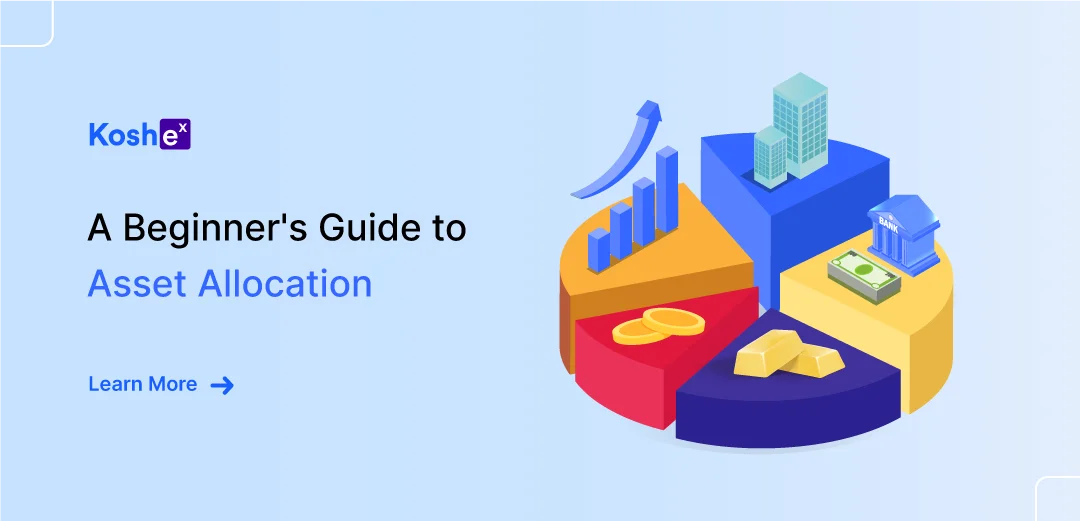The mutual fund industry in India has seen rapid growth in recent times. Between February 2013 and February 2023, the Assets Under Management (AUM) of Indian fund houses witnessed around a five-fold increase. At the end of February 2023, the AUM of the Indian mutual fund industry stood at Rs.39.46 trillion, and the total number of mutual fund accounts was at 14.42 crore.
Every mutual fund scheme in India has two variants: regular and direct plans. Buying the units of a fund through an agent is called a regular plan, and buying them directly from the fund houses is known as a direct plan.
Asset Management Companies (AMCs) allow investors to switch between regular and direct plans. Investors can also switch their investments from one fund to another within the same fund house. But before selecting any other direct plan of the same AMC, investors must consider certain factors. Let’s glance at them.
Koshex is an online platform allowing investors to put money in various mutual fund schemes. It offers both lump sum and SIP investment modes.
Direct Mutual Fund Plans
In a direct plan, investors deal directly with fund houses; there will be no intermediaries between investors and the fund house. Hence, they don’t need to pay any commission or brokerage. As a result, the expense ratio of direct plans will be less, which will be reflected in their Net Asset Value or NAV. Due to this reason, the NAV of a direct plan is always higher than that of their regular counterparts. The NAV of a mutual fund is its per-unit value, and it’s calculated by dividing the scheme’s net asset by the total number of units issued.
At the same time, investors won’t get professional or personal advice for managing their funds in direct plans. Hence, direct plans suit those who understand the market and have time to monitor their portfolio.
Regular Mutual Fund Plans
Regular plans of any mutual fund scheme are purchased through an intermediary called the agent, and investors need to pay a fee for the intermediary’s services. This fee will be included in the expense ratio of the regular plan. As a result, the expense ratio of regular plans always stands on the higher side than that of their direct plan counterparts. Regular plans are apt for those who have yet to gain experience in the market. It’s also suitable for busy bees who hardly have time to monitor their portfolios.
Direct Plan vs. Regular Plan
| Direct Plan | Regular Plan | |
| Intermediaries | No intermediaries between the investor and the fund house. | Investors put money into mutual fund schemes through an intermediary. |
| Expense Ratio | Low expense ratio as investors need not pay any commission. | Higher expense ratio due to advisory charges to the intermediary. |
| Returns | Higher returns than regular plan due to low expense ratio | Lower returns compared to the direct plan of the same scheme |
| NAV | Higher NAV than the regular plan. | Lower NAV than their direct plan counterparts due to a high expense ratio. |
| Services | No professional advice. Investors should do their research. | Intermediaries offer expert guidance to investors. They support investors in selecting the appropriate fund, doing paperwork, and making transactions. |
| Apt for | DIY investors | Newbies and those who do not have time to monitor their portfolios. |
Can I Switch From A Regular Plan To A Direct Plan Of The Same Scheme?
While investing for the first time in a scheme, investors must choose between regular and direct plans. But fund houses allow their investors to switch from a regular plan to a direct plan or vice versa later if they wish to do so.
If an investor fails to mention the direct or regular plan while investing in a scheme for the first time, then by default, their investments will fall under the direct plan.
Can I Switch Between Two Different Schemes Of The Same Fund House?
Fund houses in India allow investors to switch their investments from one scheme to another for better financial planning. However the change must be within the same fund house and satisfy the minimum investment amount criteria for switch-in and switch-out schemes.
To change their investments from one mutual fund scheme to another, investors must fill up the switch form, mentioning the number of units to be switched from the old scheme to the new one. Also, they must mention the name of the destination scheme. As the switching happens within the same fund house, they need not worry about the settlement period.
Investors who would like to switch schemes should know that switching is considered as redeeming their current units and buying units of the new or destination scheme. Hence, they will be obligated to pay capital gains tax and exit loads, if any, while switching. And the tax amount depends upon the type of the old scheme – whether it’s an equity fund or a non-equity fund.
Factors To Consider While Switching Between Mutual Fund Schemes
Before planning to switch between schemes, investors must consider the following factors:
Lock-in period: Many mutual fund schemes, such as ELSS, have a lock-in period. In such cases, switching will be possible only after the lock-in period ends. This clause is applicable for switching from a regular plan to a direct plan as well as switching between schemes.
Additionally, when an investor changes from a regular plan to a direct plan, the lock-in period will start again on the new investment. If the investor switches between schemes, the lock-in period will start again if their destination scheme has a lock-in period condition.
Suppose Mr. A invests in an ELSS scheme through the SIP route. In this case, every installment should complete the lock-in period separately to become eligible for switching. For instance, a SIP in an ELSS scheme made in June 2020 will be free from the lock-in in June 2023. Similarly, that made in July 2020 will be free from the lock-in only in July 2023.
Exit load: Usually, fund houses take a fee from investors if they exit the scheme before a stipulated period, and this penalty is called exit load. Normally, the exit load will be a certain percentage of the NAV of the fund, and it’ll be deducted at the time of the redemption.
In equity funds, if an investor sells the units before 12 months of their purchase, they’ll be obliged to pay an exit load. While switching from one plan to another or one scheme to another, the new exit load tenure will start from the new investment date.
Tax: When an investor switches between plans or schemes, it’ll be considered as a redemption for taxation purposes, and all mutual fund redemptions attract capital gains tax. Further, the tenure to qualify for the capital gains will start again from the investment date in the new scheme or plan.
Conclusion
Both direct and regular plans have their advantages and limitations. Direct plans are apt for investors with reasonable market knowledge. The primary aim of direct plans is to increase returns. On the other hand, regular plans suit novice investors who require advice and regular support in their investments.
In regular plans, the intermediary will help investors select a suitable scheme depending on their risk appetite and income. Further, the intermediary will review their portfolio periodically and rebalance it whenever necessary.
Switching between plans of a mutual fund scheme or changing your investments from one scheme to another is a good strategy for better financial planning. However, investors must make their switching decision wisely as it attracts exit loads if any, and capital gains tax. Hence, before shifting from one scheme to another or a regular to direct plan, do proper homework to avoid unnecessary tax outflows.
Koshex is an online platform that allows investors to put money in more than 10,000 mutual fund schemes of various fund houses. Sign up with Koshex to have a hassle-free mutual fund investment journey.
FAQs
How can I invest in the direct plan of a mutual fund scheme?
Investors can park their money in the direct plan of a mutual fund scheme through the website of the fund houses or online portals. Besides, those who wish to avoid making online investments can use the offline option. They can make investments through the nearest branch of the AMC.
Can I create a SIP in a direct mutual fund plan?
Yes, you can invest in a direct mutual fund in a lump sum or through the SIP route.









Leave a Comment